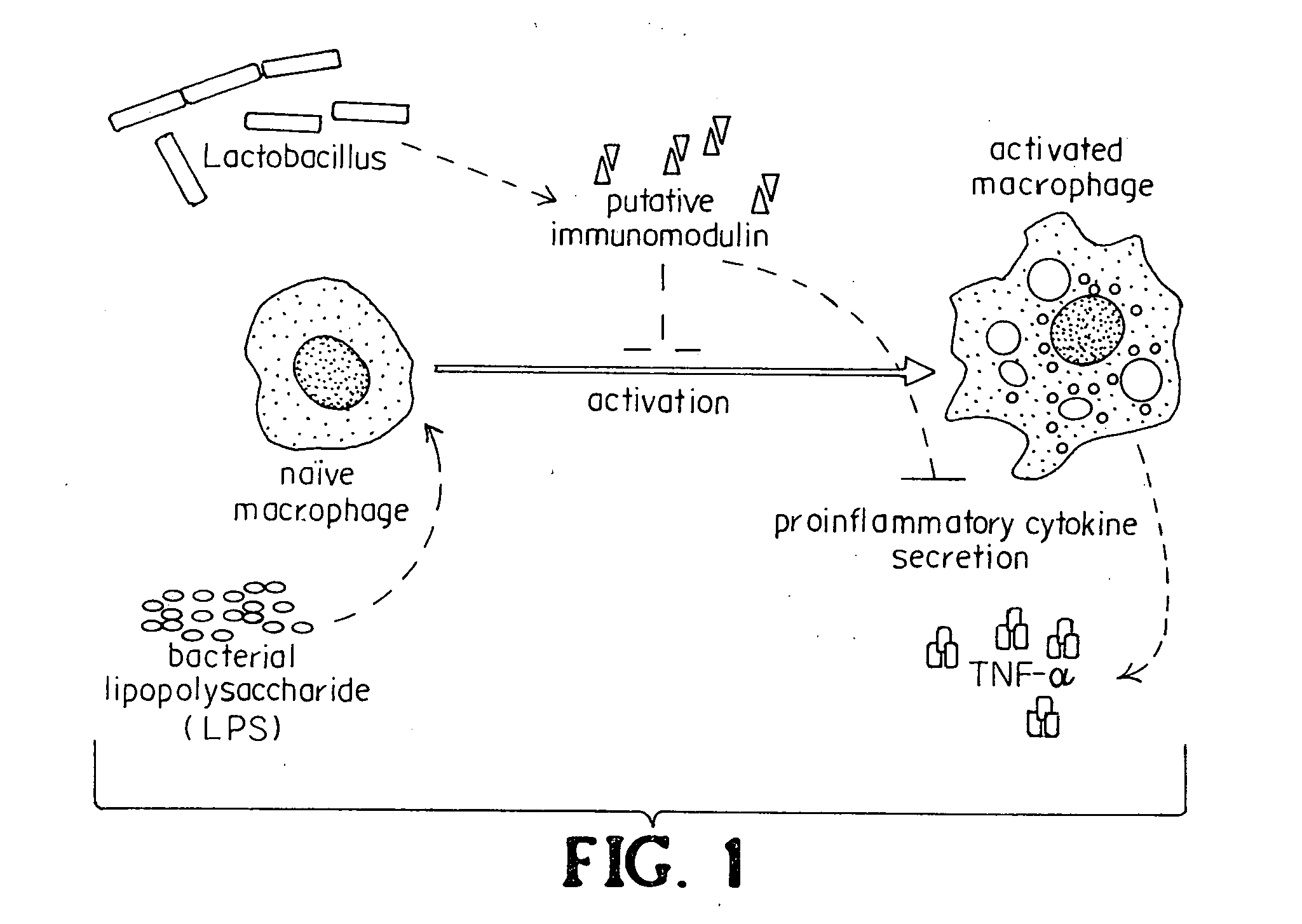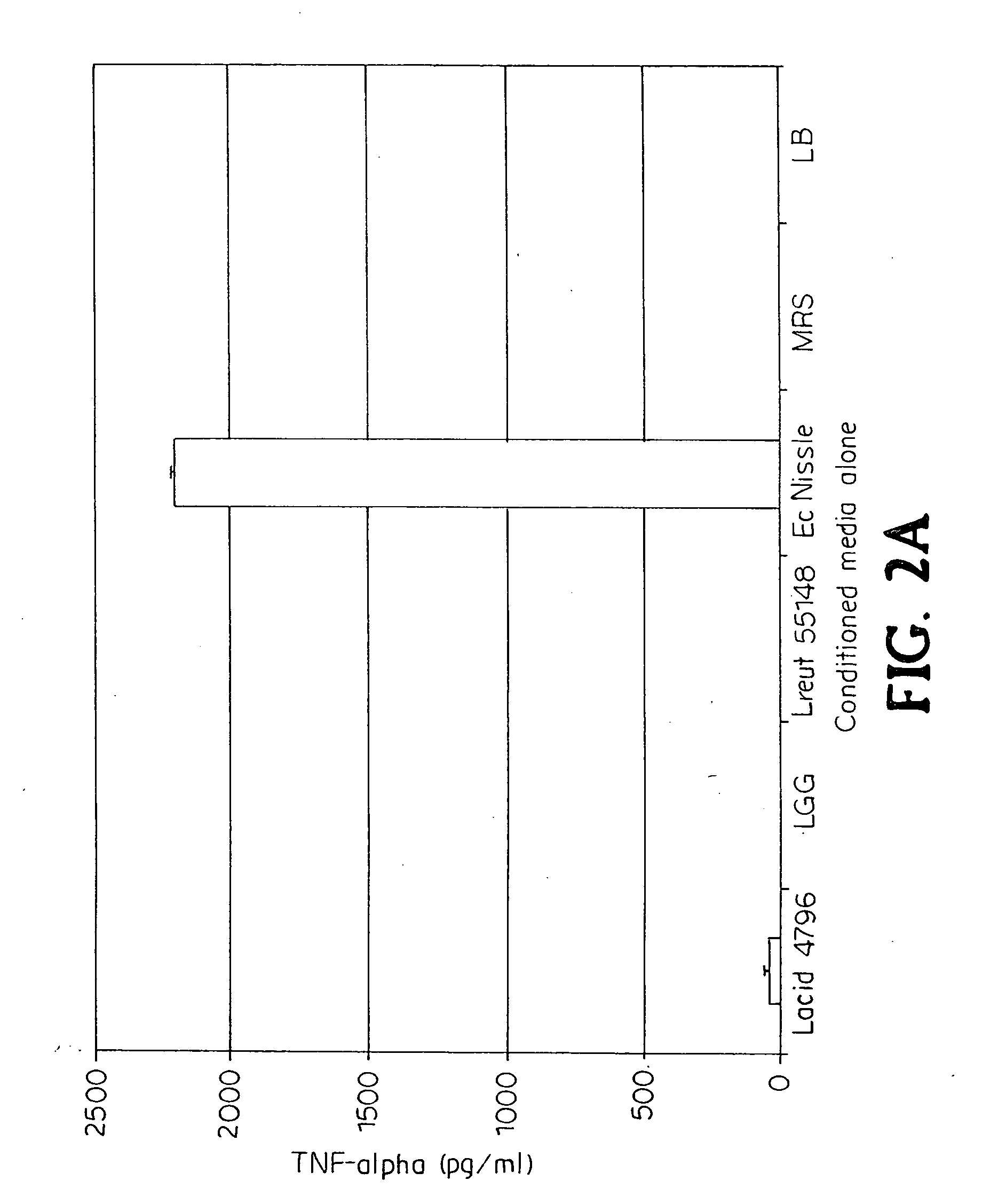Anti-inflammatory activity from lactic acid bacteria
a technology of lactic acid bacteria and anti-inflammatory molecule, which is applied in the field of immunology, medicine, cell biology, molecular biology, etc., can solve the problems of unclear molecular mechanisms of this effect, and achieve the effects of inhibiting pro-inflammatory cytokine production, inhibiting tnf- production, and promoting or regulating inflammation
- Summary
- Abstract
- Description
- Claims
- Application Information
AI Technical Summary
Benefits of technology
Problems solved by technology
Method used
Image
Examples
example 1
LGG-Mediated Inhibition of TNF-α Production by LPS-Activated Macrophages
[0111]We developed an in vitro bioassay to look at the ability of lactic acid bacterial species to down-regulate inflammatory responses in cultured macrophages (FIG. 1). Cells of the innate immune system utilize germ line-encoded pattern recognition receptors (PRRs) to recognize pathogen- or commensal-associated molecular patterns (P / CAMPs). One such P / CAMP is bacterial LPS, which that serves as a ligand to the PRR, Toll-like receptor 4 (TLR4) (Lien et al., 2000; Poltorak et al., 1998). We used RAW 264.7 macrophages, a transformed peritoneal macrophage line from BALB / c mice, as reporter cells (Raschke et al., 1978). Both wild-type RAW 264.7 macrophages and a spontaneous mutant, RAW 264.7 gamma NO(−) were compared. The gamma NO(−) cell is a spontaneous mutant requiring both IFN-γ and LPS for production of nitric oxide and full activation (Lowenstein et al., 1993). Briefly, RAW 264.7 macrophages were cultured and ...
example 2
LGG-Mediated Inhibition of TNF-α Production by LTA-Activated Macrophages
[0116]Other pathogen or commensal associated molecular pattern (P / CAMP) biomolecules, such as Gram-positive bacterial lipoteichoic acid (LTA), have been shown to activate macrophages via PRRs (Takeuchi et al., 1999). To explore the Toll-like receptor (TLR2)-mediated pathway, LGG-conditioned media was added to LTA-activated macrophages. Indeed, LGG-cm inhibited TNF-α secretion by macrophages induced by LTA from S. aureus, E. faecalis or B. subtilis. In this assay, LTA was able to induce TNF-α levels that were comparable to that of LPS. It is worth mentioning that while concentrations of LTA used in the bioassays were more than ten times that of LPS (25 ng / 50000 cells and 2 ng / 50000 cells, respectively), the same amount of LGG-cm inhibited TNF-α secretion for both LTA- and LPS-activated macrophages (see Experimental Procedures). However, when macrophages were exposed to both LPS and LTA, the TNF-α-inhibitory activ...
example 3
Evaluation of Cytokine Profiles and Bacterial-Bacterial Antagonism
[0117]To further understand the implications of TNF-α inhibition by LGG on the cytokine network of the innate immune response, we evaluated cytokine profiles of LPS-stimulated macrophages in the presence or absence of LGG-cm. Bioassays were performed and cytokines quantitated by the Luminex LabMAP 100 ™ System (Martins et al., 2002). Interleukin-1β (IL-1β), IL-10, IL-12 and TNF-α, but not granulocyte-macrophage colony stimulating factor (GM-CSF), interleukin-6 (IL-6) and interferon-gamma (IFN-γ), were detected in culture supernatants of LPS-stimulated macrophages. Levels of IL-1β and IL-10 in LGG-treated-LPS-stimulated macrophages were comparable to quantities produced by LPS-stimulated cells. A seven-fold reduction was observed in TNF-α levels in LGG-treated LPS-stimulated cells compared to LPS alone, similar to ELISA data. Interestingly, the levels of IL-10 were unaffected whether macrophages were exposed to LPS alo...
PUM
| Property | Measurement | Unit |
|---|---|---|
| pH | aaaaa | aaaaa |
| body weight | aaaaa | aaaaa |
| body weight | aaaaa | aaaaa |
Abstract
Description
Claims
Application Information
 Login to View More
Login to View More - R&D
- Intellectual Property
- Life Sciences
- Materials
- Tech Scout
- Unparalleled Data Quality
- Higher Quality Content
- 60% Fewer Hallucinations
Browse by: Latest US Patents, China's latest patents, Technical Efficacy Thesaurus, Application Domain, Technology Topic, Popular Technical Reports.
© 2025 PatSnap. All rights reserved.Legal|Privacy policy|Modern Slavery Act Transparency Statement|Sitemap|About US| Contact US: help@patsnap.com



